Sole shot at salvation calls for youth to withhold labour
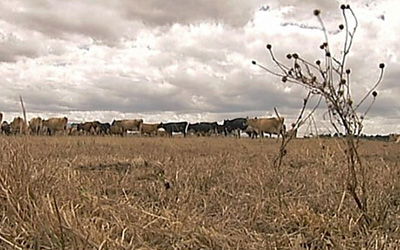
Corrected 30 March 2013
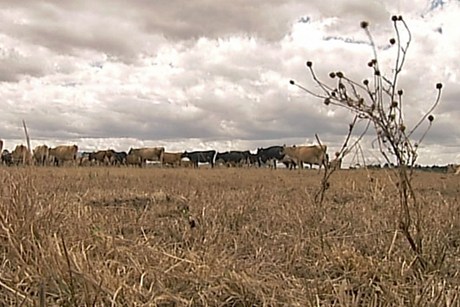
Baby Steps: The Green Party warns its supporters to expect droughts to be more extreme and to strike more often, if global action is not taken. What it doesn’t say is that this is the case regardless of the baby steps suggested. image 3 News
The Green Party doesn’t understand anthropogenic global warming:
…we can expect droughts to be more extreme and strike more often if we don’t take global action.
Never mind if—droughts will be more extreme and will strike more often, they are already.
To be fair, the Green Party may understand that global warming is largely irreversible, but be too dishonest to say so. The dishonesty, again to be fair, may be well intentioned. Climate messengers generally, climb all over each other for fear of precipitating fatalism and inaction, having been warned by social scientists of that danger. Even climate scientists frequently feel compelled to suffix an ‘if we don’t take action immediately’ qualification to their projections.
Global warming, despite the considerable discussion of the subject, is not widely understood. In 2010, the National Geographic used a bathtub analogy in an attempt to illustrate the cumulative effect of burning fossil fuels. But geosciences professor Richard Alley’s 2009 carbon dioxide as the global climate thermostat probably remains the more useful metaphor. The pre– industrial age ‘factory setting’ was roughly 280 parts per million. This provided the planet with an entirely liveable climate. Since then, the thermostat has been bumped bit-by-bit up to 400 parts per million, at least in the Arctic. There are three problems with this. Firstly, while the climate has warmed by less than one degree centigrade, the thermostat hasn’t been at 400 for long, so the warming is still catching up and ice sheets have only just started melt. Secondly, the thermostat was manufactured without a control knob, much less a remote. So even if everybody is extremely careful to avoid bumping it, it will remain stuck on its too high a setting, for at least 1000 years. There is talk of geoengineering solutions to dial it back, but the tools available are crude and untried, and could leave the thermostat stuck at an even higher setting. Finally, despite Kyoto and eleven years of talk, the bumping is bad and is getting worse. The target of limiting temperature rise to 2° is already well out of reach and the threat of runaway global warming looms nearer. How close is such calamity is, is unknowable, and because carbon dioxide levels have never risen as high as quickly in the paleoclimate record. The planet is ploughing into literally uncharted territory.
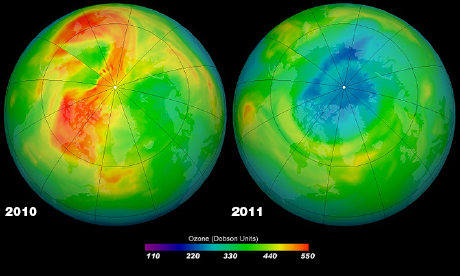
Only for a Hole to Appear Over the Arctic: While the ozone hole over the Antarctic has steadily healed, thanks to government regulation, in 2011 an unusual combination of events led to a hole appearing over the Arctic. image National Aeronautics and Space Administration
There is an environmental issue a lot like global warming in its cumulative, slow-acting effect that also has potentially catastrophic consequences for all life forms: Chlorofluorocarbons and their effect on the ozone layer. As with global warming, scientists initially struggled to convince policy makers of the danger, and were targeted by vested interests. Fortunately, compared to the fossil-fuel oligarchy, chlorofluorocarbon manufacturers had shallow pockets. But more importantly, there were affordable options available. The outcome is an exemplar of decisive intergovernmental action, and no-nonsense regulation. The solution wasn’t entrusted to the free market, any more than market forces should be relied upon to deter rape and murder.
The work derived from one litre of petrol is the equivalent of about five 40-hour weeks of manual labour. Small wonder then that global warming is proving to be an order of magnitude more difficult to address than the hole in the ozone layer. Despite all the talk, and all the photovoltaic panel production, carbon dioxide concentration in the atmosphere is accelerating. The cost of adding 30% solar photovoltaic to a power grid is between 94 and 111 times more expensive than adding the same proportion of gas-generated power. Small, wonder, again, that in 2011 China’s installed capacity, the world’s preeminent producer of photovoltaic panels, was less than 0.2% that country’s total. The Green Party and other proponents of green growth have a potentially marketable message, but the reality is that there is no technological fix, for the fix that global civilisation is in. Building electrified busways may be infinitely better than building motorways, but that is not going to feed the world. Severe ongoing drought in the United States, the world’s largest grain producer, has reduced its 2012 wheat, maize and soy harvests by more than 10%. A similarly poor harvest in many other countries, wheat down 30% in the Ukraine, means that a worldwide crisis looms this year. In the coming years, billions will be subjected to wave after wave of heat wave and pushed into extreme poverty and starvation, and there is no plausible plan being advanced to avert this hell on Earth.
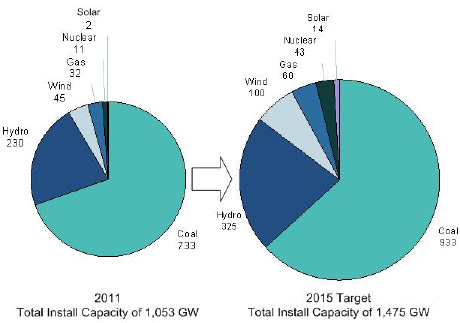
Solar Eclipsed: Despite China being the world’s solar photovoltaic panel manufacturing giant, its contribution, even to its own grid, is trivial. chart China Strategic Research
The moral response required is unarguable. The developed world must reduce its consumption dramatically, and its population, as must the developing world, whilst being helped to modestly increase its consumption. Had significant climate action commenced when scientists first noticed there was a problem with the thermostat, a policy of population replacement might just have been sustainable. More than 50 years on, the issue of reproduction and the carbon legacies of individuals can no longer be sidestepped.
Most accept the logic that population growth must, one day, cease. The rate of population increase is decelerating in many countries—Iran’s growth rate is 1.2%, down from 3.2%, despite the some of its clerics fulminating that family planning is conspiracy by Zionists to shrink the Iranian population. But the fact that a few developed countries such as Italy, Japan and Spain have falling birthrates belies the overall absolute growth, which is the equivalent of more than the population the State of California being added every six months—globally, births outnumber deaths by a factor of nearly two and a half to one. At seven billion, the planet is already overpopulated by a suggested factor of six times, setting in train the sixth great species extinction event. Meantime, resource wars such as the United States invasion of Iraq—with 5% of that country’s population killed, compared to less than 1% in the United Kingdom during World War II—are a grisly glimpse of what lies ahead under business as usual. The scenario in which global population reaches 16 billion, or even the more conservative projection of 10 billion, invites unprecedented carnage.
Thoughtful writers suggest a policy of empowering women to choose the number of children they bear. While few, other than the odd pope or other religious fundamentalist, would argue with this, it is not strategy to save the world. To ward off a world in which billions die awful lingering deaths involves a near total breeding moratorium—an epic sacrifice by several generations of women of breeding age. But it’s the young, and only the young, who have the potential to mount the united, social media –connected global moratorium needed.
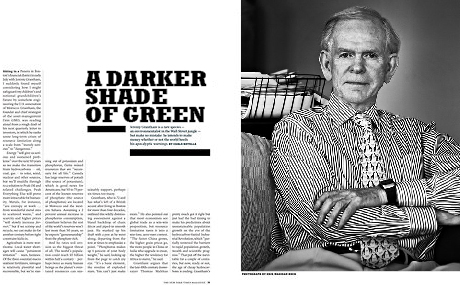
Short-Termism Eviscerated: Managing assets totalling more than US$100 billion, Jeremy Grantham both warned of the impending 2007 crash, sided with Occupy, and risked arrest outside the Whitehouse protesting the Keystone XL tar-sands pipeline. Grantham blames short-termism for a trajectory that will see global population grow to possibly six times its sustainable level. photographer Erik Madigan Heck
Beyond it being a higher calling, there is a powerful reason that young women will lead, and, heed the call—the pursuit of celebrity and power. Corporations are dependent upon growth. By acting collectively, by refusing to propagate, young people have the means to strip power from the establishment, particularly from the fossil-fuel oligarchy. The withholding of the labour of childbirth is the only language that growth-dependant corporations will ever understand. There is nothing like a falling birth rate, as Japan is acutely aware, to knock the stuffing out of a country’s gross domestic product. With the corporate world in disarray, a global grassroots democracy movement could quickly overwhelm the existing corporate-backed party machines. Barack Obama’s record-breaking fundraising in 2008 demonstrated how comprehensively the corporates can be outspent by the people.
The inability of the financial markets to reform their behaviour following the crash of 2007 is ample proof that short-termism will prevail unless power is taken back by the people. In the heyday of the labour movements, big business could always be called to account through the withholding of labour. Outsourcing, offshoring, and robotics, and the failure of unions to adapt, now means that labour can now rarely lay a glove on a corporation. An obvious alternative is the boycott, or buycott. But the inherent difficulty is in persuading sufficient consumers to put a cause ahead of their short-term interests—short-termism isn’t the sole prerogative of the ruling elite. Even 20 million-strong Avaaz has difficulty in motivating more than a million of its members to support any one action.
In addition to the breeding moratorium, there are many other epic challenges, such as rebuilding cities to function on a fraction of today’s energy. But all such greening measures would be quickly swamped without a determined return to a sustainable population, one closer to that which the world supported a century ago, about when oil first came on stream. Little of this work will be market led. The market, since Reagan and Thatcher, has had an unfettered opportunity to demonstrate that it has humanity’s best interests at heart. Its failure is as complete is it is spectacular, even by the neoliberals’ own narrow standards.
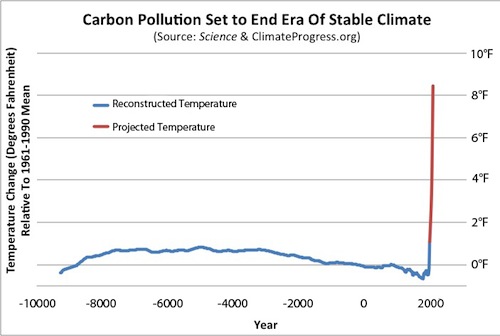
Following the Fossil Fuel Brick Wall: Never mind the much-maligned but utterly vindicated ‘hockey stick graph’, the temperature uptick following 11 300 years of benign climate graphically illustrates the magnitude of the crisis global civilisation has precipitated through the ongoing, unregulated use of fossil fuels, multiplied by population growth. chart Science and Climate Progress
The generation that saves civilisation, through largely forgoing its prerogative to have children, will be in no mood to return its hard-won power to a selfish global corporate fiefdom. It will insist that the power of the people is vested in an incorruptible global democratic order. Almost without exception, major political parties are bought and sold by big business—corporations so big that most individual states are minnows in comparison.
Finally, to be fair, the Green Party probably believes that its policies are appropriate to the problem of global warming, even if it lacked the courage to mention the c-word in its election pamphlet. If it truly understood that the thermostat had stuck, and fire had already taken hold in the tinder-dry ceiling, it would not be talking renovation but of moving the vulnerable to safety. The party would be freely admitting that there is no realistic route by which fossil fuel use can be replaced with alternatives sufficiently quickly and cleanly, and that only a virtual breeding moratorium now stands between salvation and Armageddon.
Youth, and only youth, has the power to withhold the labour of childbirth, and stave off the brutish collapse of global civilisation.

A breeding pause is not going to leave the fossil fuels in the ground. At best it will delay fossil fuel use and provide some breathing space. The only thing that will limit fossil fuel use is penalties for extraction and use, combined with incentives for alternatives. Unfortunately as a species most of us do not seem to be smart enough to think very far ahead and we lack the political leadership that is prepared to think beyond the next election.
We have been in contact before, but I thought you might like to see my new web site. http://www.climateoutcome.kiwi.nz